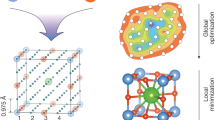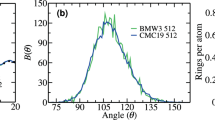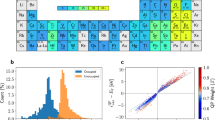Abstract
Modern crystal-growth techniques, such as molecular beam epitaxy or metal–organic chemical-vapour deposition, are capable of producing prescribed crystal structures, sometimes even in defiance of equilibrium, bulk thermodynamics. These techniques open up the possibility of exploring different atomic arrangements in search of a configuration that possesses given electronic and optical properties1. Unfortunately, the number of possible combinations is so vast, and the electronic properties are so sensitive to the details of the crystal structure, that simple trial-and-error methods (such as those used in combinatorial synthesis2) are unlikely to be successful. Here we describe a theoretical method that addresses the problem of finding the atomic configuration of a complex, multi-component system having a target electronic-structure property. As an example, we predict that the configuration of an Al0.25Ga0.75As alloy having the largest optical bandgap is a (GaAs)2(AlAs)1(GaAs)4(AlAs)1 superlattice oriented in the [201] direction.
This is a preview of subscription content, access via your institution
Access options
Subscribe to this journal
Receive 51 print issues and online access
$199.00 per year
only $3.90 per issue
Buy this article
- Purchase on Springer Link
- Instant access to full article PDF
Prices may be subject to local taxes which are calculated during checkout



Similar content being viewed by others
References
Capasso,F. Physics of Quantum Electron Devices (Springer, Berlin, 1990).
Wilson,S. R. & Czarnik,A. W. Combinatorial Chemistry: Synthesis and Application (Wiley, New York, 1997).
Magri,R. & Zunger,A. Real-space description of semiconducting band gaps in substitutional systems. Phys. Rev. B 44 , 8672–8684 (1991).
Werner,J. H., Kolodinski,S. & Queisser, H. J. Novel optimization principles and efficiency limits for semiconductor solar cells. Phys. Rev. Lett. 72, 3851–3854 (1994).
Silverman,A., Zunger,A., Kalish,R. & Adler,J. Atomic-scale structure of disordered Ga1-xInxP alloys. Phys. Rev. B 51, 10795–10816 (1995).
Zunger,A. & Freeman,A. J. Ground- and excited-state properties of LiF in the local-density formalism. Phys. Rev. B 16, 2901–2926 (1977).
Chelikowsky,J. R. & Cohen,M. L. Nonlocal pseudopotential calculations for the electronic structure of eleven diamond and zinc-blende semiconductors. Phys. Rev. B 14, 556– 582 (1976).
Wang,L. W. & Zunger,A. Local-density-derived semiempirical pseudopotentials. Phys. Rev. B 51, 17398 –17416 (1995).
Mader,K., Wang,L. W. & Zunger,A. Electronic structure of intentionally disordered AlAs/GaAs superlattices. Phys. Rev. Lett. 74, 2555 –2558 (1995).
Mattila,T., Wei,S.-H. & Zunger,A. Electronic structure of “sequence mutations” in ordered GaInP2 alloys. Phys. Rev. Lett. 83, 2010–2013 (1999).
Wang,L. W. & Zunger,A. Solving Schrödinger's equation around a desired energy: Application to silicon quantum dots. J. Chem. Phys. 100, 2394–2397 (1994).
Bellaiche,L., Wei,S. H. & Zunger,A. Localization and percolation in semiconductor alloys: GaAsN vs. GaAsP. Phys. Rev. B 54, 17568– 17576
Acknowledgements
This work was supported by the US Department of Energy, Office of Science, Division of Materials Science.
Author information
Authors and Affiliations
Corresponding author
Rights and permissions
About this article
Cite this article
Franceschetti, A., Zunger, A. The inverse band-structure problem of finding an atomic configuration with given electronic properties. Nature 402, 60–63 (1999). https://doi.org/10.1038/46995
Received:
Accepted:
Issue Date:
DOI: https://doi.org/10.1038/46995
This article is cited by
-
Inverse Hamiltonian design by automatic differentiation
Communications Physics (2023)
-
Physics guided deep learning for generative design of crystal materials with symmetry constraints
npj Computational Materials (2023)
-
Human- and machine-centred designs of molecules and materials for sustainability and decarbonization
Nature Reviews Materials (2022)
-
Spontaneous polarization study in A3+B4+(O2N)7− and A2+B5+(O2N)7− perovskite-type oxynitrides: a first principles investigation
Applied Physics A (2022)
-
Inverse design of glass structure with deep graph neural networks
Nature Communications (2021)
Comments
By submitting a comment you agree to abide by our Terms and Community Guidelines. If you find something abusive or that does not comply with our terms or guidelines please flag it as inappropriate.



